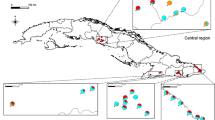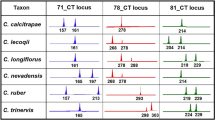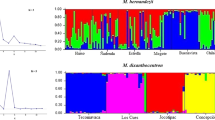Abstract
Cacao (Theobroma cacao L.) is indigenous to the Amazon region of South America. The river basins in the Upper Amazon harbor a large number of diverse cacao populations. Since the 1930s, several numbers of populations have been collected from the present-day Peruvian Amazon and maintained as ex situ germplasm repositories in various countries, with the largest held in the International Cacao Genebank in Trinidad. The lack of information on population structure and pedigree relationship and the incorrect labeling of accessions are major concerns for efficient conservation and use of cacao germplasm. In the present study, we assessed the individual identity, sibship, and population structure in cacao populations collected from the present-day Loreto Region, Peru in the 1930–1940s. Using a capillary electrophoresis genotyping system, we analyzed the simple sequence repeat variation of 612 cacao accessions collected from the Marañon, Nanay, and Ucayali river systems. A total of 180 cases of mislabeling were identified using a Bayesian clustering method for admixture detection. Using maximum likelihood-based methods, we reconstructed 78 full-sib families nested in 48 half-sib families, indicating that the pods collected in the 1930s were from 48 mother trees, maximum. Likelihood simulation also identified eight probable parents that are responsible for 117 pairs of mother–offspring relationships in this collection. Principal coordinate analysis (PCoA) and the Bayesian clustering method cohesively demonstrated a pronounced structure of genetic diversity, stratified by the river systems of the Peruvian Amazon. Our results also show that, in spite of the high level of allelic diversity in this collection, it was composed of a large number of related family members collected from a relatively small area, including a couple of sites in the Ucayali and Nanay rivers, as well as the lower Marañon river near Iquitos. The vast majority of the Peruvian Amazon, especially the upper Marañon River and its tributaries, have not been sampled by collecting expeditions. The improved understanding of the individual identities, genealogical relationships, and geographical origin of cacao germplasm in this collection will contribute to more efficient conservation and utilization of these germplasm. Additionally, this study also provides more baseline information to help guide future collecting expeditions in the Peruvian Amazon.



Similar content being viewed by others
References
Aikpokpodion PO, Adetimirin VO, Ingelbrecht I, Schnell RJ, Kolesnikova-Allen M (2005) Assessment of Genetic diversity of cacao, Theobroma cacao L., Collections in Nigeria using simple sequence repeat markers. In: Malaysian Intl Cocoa Conf Sustainable Cocoa Economy through Increase in Productivity, Efficiency and Quality, pp 83–86
Bartley BGD (1994) A review of cacao improvement: fundamentals, methods and results. Proc Intl Workshop Cocoa Breeding Strategies, pp 3–16. Available at http://ingenic.cas.psu.edu/proceedings.htm
Bartley BGD (2005) The genetic diversity of cacao and its utilization. CAB International, Wallingford, Oxfordshire
Boccara M and Zhang D (2006) Progress in resolving identity issues among the Parinari accessions held in Trinidad: the contribution of the collaborative USDA/CRU project. CRU Annu Rpt 2005, Cacao Research Unit, The University of the West Indies, St. Augustine, Trinidad and Tobago
Bowers JH, Bailey BA, Hebbar PK, Sanogo S, Lumsden RD (2001) The impact of plant diseases on world chocolate production. Plant Health Progress (online). doi:10.1094/PHP-2001-0709-01-RV
Cheesman EE (1944) Notes on the nomenclature, classification and possible relationships of cocoa populations. Trop Agric 21:144–159
Cryer NC, Fenn MGE, Turnbull CJ, Wilkinson MJ (2006) Allelic size standards and reference genotypes to unify international cocoa (Theobroma cacao L.) microsatellite data. Genet Resour Crop Evol 53:1643–1652. doi:10.1007/s10722-005-1286-9
Cuatrecasas J (1964) Cacao and its allies: A taxonomic revision of the genus Theobroma. Contributions from the United States National Herbarium, vol. 35. Smithsonian Institution Press, Washington, DC, pp 375–614
Dias LAS (2001) Genetic improvement of cacao. Editora Folha de Vicosa Ltda. Trans. Abreu-Reichart CE, Vicosa, MG, Brazil, supported by FAO (2005). Available at http://ecoport.org/ep?SearchType=earticleView&earticleId=197
Efombagan IB, Motamayor JC, Sounigo O, Eskes AB, Nyasse S, Cilas C, Schnell RJ, Manzanares-Dauleux M, Kolesnikova-Allen M (2008) Genetic diversity and structure of farm and genebank accessions of cacao (Theobroma cacao L.) in Cameroon revealed by microsatellite markers. Tree Genetics & Genomics 4:821–831. doi:10.1007/s11295-008-0155-z
Evett IW, Weir BS (1998) Interpreting DNA evidence: statistical genetics for forensic scientists. Sinauer, Sunderland, MA
Gómez-Pompa A, Flores JS, Fernandez MA (1990) The sacred cacao groves of the Maya. Latin Am Antiq 1:247–257. doi:10.2307/972163
Henderson JS, Joyce RA, Hall GR, Hurst WJ, McGovern PE (2007) Chemical and archaeological evidence for the earliest cacao beverages. Proc Natl Acad Sci U S A 104:18937–18940
Hunter RJ (1990) The status of cocoa (Theobroma cacao, Sterculiaceae) in the western hemisphere. Econ Bot 44:425–439
Iwaro AD, Bekele FL, Butler DR (2003) Evaluation and utilization of cacao (Theobroma cacao L.) germplasm at the International Cocoa Genebank, Trinidad. Euphytica 130:207–221
Johnson ES, Mora A, Schnell RJ (2007) Field guide efficacy in the identification of reallocated clonally propagated accessions of cacao (Theobroma cacao L.). Genet Resour Crop Evol 54:1301–1313
Kalinowski ST, Taper ML, Marshall TC (2007) Revising how the computer program CERVUS accommodates genotyping error increases success in paternity assignment. Mol Ecol 16:1099–1006
Kennedy AJ, Mooleedhar V (1993) Conservation of cocoa in field genebanks—the International Cocoa Genebank, Trinidad. In: Proceedings of the International Workshop on Conservation, Characterization and Utilization of Cocoa Genetic Resources in the 21st Century. The University of the West Indies, Cocoa Research Unit, Port-of-Spain, Trinidad and Tobago, pp 21–23
Kobayashi N, Horikoshi T, Katsuyama H, Handa T, Takayanagi K (1998) A simple and efficient DNA extraction method for plants, especially woody plants. Plant Tissue Cult Biotechnol 4:76–80
Lanaud C, Motamayor JC, Risterucci AM (2001) Implications of new insight into the genetic structure of Theobroma cacao L. for breeding strategies. In: Proceedings of the International Workshop on New Technologies for Cocoa Breeding. Ingenic Press, Kota Kinabalu, Malaysia, London, pp 89–107
Lanaud C, Risterucci AM, Pieretti I, Falque M, Bouet A, Lagoda PJL (1999) Isolation and characterization of microsatellites in Theobroma cacao L. Mol Ecol 8:2141–2143
Liu J, Muse S (2005) PowerMarker: an integrated analysis environment for genetic marker analysis. Bioinformatics Applications Note 21:2128–2129 (doi:10.1093/bioinformatics/bti282) (Free Program, v 3.23, distributed by author, available at http://www.powermarker.net)
Lockwood C, End M (1993) History, technique and future needs for cacao collection. In: Proceedings of the Workshop on the Conservation, Characterization and Utilization of Cacao Genetic Resources in the 21st Century, 13–17 September, 1992, Port-of-Spain. Trinidad and Tobago, The University of the West Indies, The Cacao Research Unit, pp 1–14
Marshall TC, Slate J, Kruuk LEB, Pemberton JM (1998) Statistical confidence for likelihood-based paternity inference in natural populations. Mol Ecol 7:639–655
Motamayor JC, Lopez PA, Ortiz CF, Moreno A, Lanaud C (2002) Cacao domestication. I. The origin of the cacao cultivated by the Mayas. Heredity 89:380–386
Motamayor JC, Lachenaud P, Wallace J, Loor G, Kuhn DN, Brown JS, Schnell Ii RJ (2008) Geographic and genetic population differentiation of the Amazonian chocolate tree. PLoS One 3:e3311. doi:10.1007/s12042-008-9011-4
Peakall R, Smouse PE (2006) Genalex 6: genetic analysis in Excel. Population genetic software for teaching and research. Mol. Ecol. Notes 6:288–295
Posnette AF (1986) Fifty years of cocoa research in Trinidad and Tobago. Cocoa Research Unit, University of the West Indies, St. Augustine, Trinidad
Pound FJ (1938) Cacao and witches' broom disease (Marasmius perniciosus) of South America. Arch Cacao Res 1:20–72
Pound FJ (1943) Cacao and witches’ broom disease (Marasmius perniciosus). Report on a recent visit to the Amazon territory of Peru, September, 1942–February, 1943. Yuille’s Printery, Port of Spain, Trinidad and Tobago
Pound FJ (1945) A note on the cocoa population of South America. In: Report and Proceedings of the 1945 Cocoa Conference. London, pp 131–133
Pritchard JK, Stephens M, Donnelly P (2000) Inference of population structure from multilocus genotype data. Genetics 155:945–959
Risterucci AM, Grivet L, Ngoran JA, Pieretti I, Flamen MH et al (2000) A high-density linkage map of Theobroma cacao L. Theor Appl Genet 101:948–955
Risterucci AM, Eskes B, Fargeas D, Motamayor JC, Lanaud C (2001) Use of microsatellite markers for germplasm identity analysis in cocoa. In: Proc Intl Workshop on New Technologies and Cocoa Breeding, pp 25–33. Available via http://ingenic.cas.psu.edu/proceedings.htm.
SAS Institute Incorporated (1999) SAS Version 8.02: SAS/STAT Software: Changes and enhancements through Release 8.02. SAS Institute Inc., Cary, NC, USA
Saunders JA, Hemeida AA, Mischke S (2001) USDA DNA fingerprinting programme for identification of Theobroma cacao accessions. In: Bekele F, End M, Eskes AB (eds) Proceeding of the International Workshop on New Technologies and Cocoa Breeding, 16–17 October 2000, Kota Kinabalu, Sabah, Malaysia. INGENIC Press, Malaysia, pp 108–114
Saunders JA, Mischke S, Leamy EA, Hemeida AA (2004) Selection of international molecular standards for DNA fingerprinting of Theobroma cacao. Theor Appl Genet 110:41–47
Schnell RJ, Olano CT, Brown JS, Meerow AW, Cervantes-Martinez C, Nagai C, Motamayor JC (2005) Retrospective determination of the parental population of superior cacao (Theobroma cacao L.) seedlings and association of microsatellite alleles with productivity. J Am Soc Hortic Sci 130:181–190
Sereno ML, Albuquerque PSB, Vencovsky R, Figueira A (2006) Genetic diversity and natural population structure of cacao (Theobroma cacao L.) from the Brazilian Amazon evaluated by microsatellite markers. Conserv Genet 7:13–24
Sounigo O, Christopher Y, Ramdahin S, Umaharan R, Sankar A (2000) Evaluation and use of the genetic diversity present in the International Cacao Genebank (ICG,T), in Trinidad. In: Proceedings of the 3rd INGENIC International Workshop on the New Technologies and Cocoa Breeding, Kota Kinabalu, Sabah, Malaysia.
Wadsworth RM, Ford CS, End MJ, Hadley P (eds) (1997) International cacao germplasm database. The London International Financial Futures and Options Exchange (LIFFE), London, UK.
Waits LP, Luikart G, Taberlet P (2001) Estimating the probability of identity among genotypes in natural populations: cautions and guidelines. Mol Ecol 10:249–256
Wang J (2004) Sibship reconstruction from genetic data with typing errors. Genetics 166:1963–1979
Wright S (1965) The interpretation of population structure by F-statistics with special regard to systems of mating. Evolution 19:395–420
Zhang D, Mischke S, Goenaga R, Hemeida AA, Saunders JA (2006a) Accuracy and reliability of high-throughput microsatellite genotyping for cacao clone identification. Crop Sci 46:2084–2092
Zhang D, Arevalo-Gardini E, Mischke S, Zúñiga-Cernades L, Barreto-Chavez A et al (2006b) Genetic diversity and structure of managed and semi-natural populations of cacao (Theobroma cacao) in the Huallaga and Ucayali valleys of Peru. Ann Bot 98:647–655
Zhang D, Boccara M, Motilal L, Butler DR, Umaharan P, Mischke S, Meinhardt L (2008) Microsatellite variation and population structure in the “refractario” cacao of Equador. Conserv Genet 9:327–337. doi:10.1007/s10592-007-9345-8
Zhang D, Mischke S, Johnson ES, Phillips-Mora W, Meinhardt L (2009) Molecular characterization of an International cocoa collection using microsatellite markers. Tree Genetics & Genomes 5:1–10. doi:10.1007/s11295-008-0163-z
Acknowledgements
We wish to thank Stephen Pinney, Eric Tillson, Emily Leamy, Elizabeth Gingold, and Sarah Gingold for assisting with the microsatellite genotyping. Enrique Arevalo is thanked for providing leaf samples of the Ucayali clones. Antoinette Sankar is thanked for performing the DNA extractions at CRU, Trinidad. Special thanks are due to Dr. Ainong Shi and two anonymous reviewers for their review of the manuscript and suggestions for the revision.
Author information
Authors and Affiliations
Corresponding author
Additional information
Communicated by E. Dirlewanger
Rights and permissions
About this article
Cite this article
Zhang, D., Boccara, M., Motilal, L. et al. Molecular characterization of an earliest cacao (Theobroma cacao L.) collection from Upper Amazon using microsatellite DNA markers. Tree Genetics & Genomes 5, 595–607 (2009). https://doi.org/10.1007/s11295-009-0212-2
Received:
Revised:
Accepted:
Published:
Issue Date:
DOI: https://doi.org/10.1007/s11295-009-0212-2




